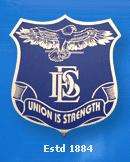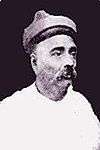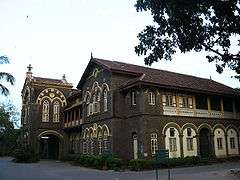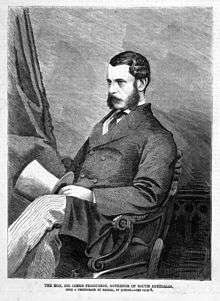Fergusson College
Coordinates: 18°31′26″N 73°50′21″E / 18.523969°N 73.839219°E
 Logo of Deccan Education Society | |
| Motto | Knowledge is Power |
|---|---|
| Type | Public Co-ed |
| Established | 1884 |
| Affiliation | Savitribai Phule Pune University |
| Chairperson | Deccan Education Society |
| Principal | Dr. Ravindrasinh G. Pardeshi[1] |
| Vice principals |
Dr. N.M. Kulkarni Prof. P.M. Pawar Dr. S. P. Khedkar Deshpande Mam[1] |
Academic staff | 246 |
Administrative staff | 130 |
| Students |
Junior Wing: 2400 Senior Wing: 4550 |
| Address | Fergusson College Road, Pune, Maharashtra, India |
| Website | www.fergusson.edu |
Fergusson College (FC) is an Autonomous public educational institution offering courses in the streams of Arts and Science in the city of Pune.[2][3][4] It was founded in 1885 by the Deccan Education Society.[5] Professor Vaman Shivram Apte was its first principal.[6] Social reformer, journalist, thinker and educationist Gopal Ganesh Agarkar served as the second principal from August 1892 till his death in June 1895.[7]
The college is named after Scottish born Sir James Fergusson, the Governor of Bombay, who donated Rs 1,200. Since 1948, the college has been under the jurisdiction of the University of Pune.
The college has two sections:
- The Junior Wing is for students graduating from school. Courses are offered in Arts and Science streams, at the end of which students may appear for the Higher-Secondary State Certificate examination.
- The Senior Wing offers bachelor's degrees in 29 disciplines and master's degrees in 16 disciplines, spanning electronic and computer sciences, languages, humanities and social science, life sciences and creative sciences.
The college also offers doctoral and vocational programs.[8]
Fergusson College is known for its close association with Indian politics. Its founders were pioneers of the Indian National Congress,[9] as well as ,Indian Socialist Movement.[10] The college has produced, several ministers and legislators, including two Indian Prime Ministers.[11][12][13]
Fergusson was among the 19 colleges to get a heritage tag by the central government and UGC in 2015. The college will receive financial help from UGC for the conservation of campus and buildings.[14] The 65-acre (260,000 m2) campus is in the heart of the city. It provides athletic and cultural facilities, as well as residential facilities for more than 600 students and faculty.[15]
History
Foundation and growth during British Colonial rule
After the Revolt of 1857, Indian luminaries saw a pressing need to modernise the education system to fight against British imperialism by democratic means. Indian Nationalists such as Bal Gangadhar Tilak, Vishnushastri Chiplunkar, and social reformer Gopal Ganesh Agarkar and Mahadev Namjoshi put their efforts into the formation of a school for their countrymen. The result was The New English School.
Boosted by its success, the Deccan Education Society was formed in 1884; a year later Fergusson College was founded. An area of 37 acres (150,000 m2) of land was donated for one rupee on a 99-year lease by Shirole, the erstwhile Patil of the village of Bhamburde (now called Shivaji Nagar) on the west bank of the Mutha river.
The college was inaugurated by William Wordsworth, the grandson of the famous poet and principal of Elphinstone College in Bombay. Other leaders such as R G Bhandarkar and M G Ranade played a part in the construction.[16] The college was named after the then Governor of Bombay, Sir James Fergusson. The British colonial Government in Bombay allowed the college to remain autonomous, giving it a free hand in education.
In 1935, the college completed 50 years of existence. Sir CV Raman, India's only Science Nobel laureate at that time, was the president of the Golden Jubilee celebrations. He said in his speech,
| “ | … Standing here today, I feel that history has been written in Poona- history of self-help, history of self-reliance, history of great and constructive national effort- that history has been written in Poona, has been written on this very spot … | ” |
Mahatma Gandhi, in a message to then Principal Dr. Mahajani wrote,
| “ | Who will fail to be enthused over the noble record of the service rendered by the D. E. Society and the Fergusson College to the cause of education?[17] | ” |

Post-independence
Post-1947, Fergusson College has produced leaders in the fields of politics, academia, literature and art. Dr. Rajendra Prasad, India's first president, was the chief guest of the platinum jubilee function. He said on the occasion,
| “ | The Fergusson College was established at a time when the attitude of the Indian masses towards higher education of the western type was yet in a formative stage and when facilities for such education for the generality of Indian students were inadequate… It was an enterprise, which benefited the Nation without offending or alienating the then rulers of India. Fergusson College is the foremost fruit of that effort.[18] | ” |
In 1985, the college completed its centenary. Rajiv Gandhi, the then prime minister was the president of the ceremony. PV Narasimharao, India's 12th prime minister and former student, said,
| “ | This college, born like a twin of the Indian National Congress, has always kept abreast of the country's history. It has produced political leaders of all hues of the political spectrum including ultras and infras, if I may say so, administrators, eminent scholars, researchers, writers, sportsmen and many other categories of celebrities, which any country can be proud of.[19] | ” |
A two-part history of the college was written by Dr. VM Bachal, former principal. The book, Vatchal Sawashe Varshanchi (A Journey of 125 Years) was published in January 2010.[20]
Association with Indian politics
Fergusson College has been given many epithets by political leaders, including 'cradle of Indian polity' and 'twin of the Congress'.[19]

The founders of Fergusson College, most notably Tilak and Gokhale, were leaders of the Indian National Congress in its early stages from 1885 to 1920. In fact, most historians divide the history of the INC into two eras — the Tilak Era and the Gandhi era.[21] The college has produced as alumni, notable Congress leaders including Vishwanath Pratap Singh and PV Narasimha Rao, Jivatram Kripalani and Babubhai J Patel. (See comprehensive list below.)
Among the founders, Agarkar and Namjoshi were early Socialists of Maharashtra.[22] Alumni such as Vitthal Ramji Shinde, S.M. Joshi, and Nanasaheb Gore were eminent socialists, inside and outside the Congress fold. The Samyukta Maharashtra Movement, founded to fight for Maharashtra's statehood, included several alumni such as Prahlad Keshav Atre, SM Joshi and Gore. V.D Savarkar, in 1902, enrolled in Fergusson College. As a young man, he was inspired by the new generation of radical political leaders — Bal Gangadhar Tilak, Bipin Chandra Pal and Lala Lajpat Rai — along with the political struggle against the partition of Bengal and the rising Swadeshi campaign. After completing his degree, nationalist activist Shyamji Krishna Varma helped Vinayak to go to England to study law, on a scholarship.[23]
Fergusson is the only institution in India to have in its alumni two Indian prime ministers.[11][12][13]
Campus

From the 37 acres (150,000 m2) leased out by Shirole, the erstwhile Patil of Bhamburde in 1881, the college expanded to 65 acres (260,000 m2) by the time of Independence.[24] The road that runs along the college is named after it and is one of the busiest in Pune. The campus extends until the slopes of a hillock, popularly called Fergusson Hill. Several educational institutions are around the hillock. The college is largely built in accordance with the Victorian school of architecture, although it has some Gothic and traditional Indian styles as well.
Main building and departments
The Main Building is at the inner entrance of the college. Built entirely in Victorian style, the two-storey structure houses the central office and the principals' chambers. The Statistics and Psychology Departments lie to the east of the main building; the Economics Department lie to the west. The computer science and the life science buildings are also to the west.
On the southern side are the RP Paranjpye building, Pittie Chemistry building, Botany, Zoology, Geology, Electronics and Physics departments. The building overlooks the central garden to the north and has two lecture halls and the staffs' chambers. There are 55 laboratories and 51 lecture halls in all.
NM Wadia Amphitheatre
The three-storeyed amphitheatre building, to the west of the central garden, has Victorian-Gothic influences. Apart from several lecture halls, the building houses an auditorium with a capacity of 1,000 people. This famous amphitheater recently celebrated its 100 years.
Bai Jerbai Wadia Library
Bai Jerbai Wadia Library was built in 1929 by industrialists Sir Cusrow Wadia and Sir Ness Wadia in memory of their mother. The Main Library on the ground floor has more than 300,000 books and research journals.[25] Research scholars and book-lovers have donated their collections.
The first floor (the floor above the ground floor) of the library serves as a Reading Hall for students and accommodates 400 students. The floors above this floor are not publicly accessible without prior arrangement and house books, manuscripts, and articles of historic and cultural importance. The library has a collection of statues and posters, dedicated to national leaders and educationalists. The building was extended in 1955, with government grants and then in 1982 with grants from the Central government.
Kimaya
Kimaya is an open-air theatre on the north side of the campus. It was conceived by litterateur and alumni PL Deshpande on his return from a visit to Japan. It is a student hang-out and most of the students' activities are held there. It encompasses elements of modern architecture and is built without beams. It has eight walls fused together, which function as trusses.
Botanical Gardens
The 2-acre (8,100 m2) Botanical Gardens on the campus were founded in 1902 by a teacher, Professor Shevade. It is known for its medicinal plants and wild ferns. Botany students from the college planted specimens here, including Elaeocarpus, Araucaria and Mahogany. In 1961, the garden was destroyed when the nearby Panshet dam was breached. Years later, it was reinstated by the Pune Municipal Corporation (PMC), the Association of Herbal Drugs, and Deccan Education Society. Some plants found there are Saraca Indica (Sita Ashok), the bark of which is used to heal skin diseases and as a tonic; and Terminalia arjuna, the extract of which is used to treat jaundice.[26]
Gymkhana and grounds
Cricket, hockey and football are played on the main ground which has a drainage system, enabling play during monsoons. Two asphalted basketball courts are next to the main ground. A second ground, to the south, has courts for volleyball and handball as well as facilities for Indian sports like Kabaddi, Kho-Kho and Mallakhamb. Services for badminton and other indoor games are available, and the Gymnasium Building provides training for boxing, wrestling, judo, weight lifting and yoga. The college has tennis courts on the eastern side of the campus.
New academic complex
The new academic complex was built in 2004 at the northern end of the campus. Unlike the other buildings, it is designed in a modern functionalist style. It houses the Junior College and the DES Law College.
Residences
For students, there are six hostel blocks, four blocks for boys and two for girls. The total intake capacity of the hostels is 587 students. The gents hostel blocks are to the north of the campus and the ladies hostel blocks lie to the east.
The college has some quarters for the faculty and staff and also for employees of other DES Institutes. The spacious bungalows, built on the old British design, near the main gate and the ladies’ hostel gate, have a colonial-era charm.
The principal resides in an independent bungalow at the main entrance of the college. Some members of the teaching staff have been provided with residential facilities on the campus. This facility includes independent bungalows. There are some flats constructed with financial aid from the UGC.
Associated institutes
The college shares its campus with the Institute of Management Development and Research, Pune (IMDR) and Jaganath Rathi Vocational Guidance and Training Institute (JRVGTI), both governed by the Deccan Education Society. Brihan Maharashtra College of Commerce (BMCC), established in 1943, is closely associated with Fergusson College. At the northern end of the campus, next to the New Academic Building, lies DES Law College.
Awards and rankings
In 2004, Fergusson College was awarded an 'A' grade by the National Assessment and Accreditation Council (NAAC).[27] The College also received the "Best College Award" of the colleges affiliated to the University of Pune in the academic year 2004–2005.College has also gotten 'A'(Equivalent to "A+" grade in current scheme) grade with CGPA 3.26 in NAAC second cycle reaccreditation in year 2010 and again gotten 'A'(Equivalent to "A++" grade in current scheme) grade with CGPA 3.62 in NAAC third cycle in year 2015. It has also received national heritage status, College of Excellence by(UGC) award and It is part of DBT STAR College Scheme.
Fergusson College has ranked in the top ten arts and science colleges in India for the past 16 years in the annual survey conducted by India Today-AC Nielsen-ORG-MARG and published in India Today magazine.[28][29] In the state of Maharashtra, it is consistently ranked first in science and arts, followed by St. Xavier's College, Mumbai.[30]
| Year | 2018 | 2017 |
|---|---|---|
| NIRF(Overall Rank of College) | 19 | 35 |
| NIRF(Rank of College within State) | 1 | 2 |
| Year | Nationwide rank: Arts | Nationwide rank: Science |
|---|---|---|
| 2012 | 12 | 8 |
| 2011 | 9 | 5 |
| 2010 | 7 | 6 |
| 2009 | 10 | 7 |
| 2008 | 7 | 7 |
| 2007 | 6 | 9 |
| 2006 | 8 | 6 |
| 2005 | 5 | 6 |
Notable alumni
- Stephie D'Souza (1936–1998) — Indian athlete who won Gold, Silver and Bronze medals at the 1954 and 1958 Asian Games.
- N. H. Antia (1922–2007) — plastic surgeon and Padma Shri recipient
- Radhika Apte (born 1985) — actress
- Padmanabhan Balaram — biochemist, Padma Bhushan recipient
- Pooja Batra (born 1979) — actress and model, Miss India 1993
- Milind Date — composer, flautist
- Bhaskar Chandavarkar (1936–2009) — sitar player, academic and composer
- P. L. Deshpande (1919–2000) — Marathi writer, actor, music composer, film and television producer, film director, music director
- Madhav Gadgil (born 1942) — ecologist
- Chandrashekhar Agashe (1888–1956) — industrialist
- Ram Ganesh Gadkari (1885–1919) — Marathi playwright, poet and writer
- Aarya Ambekar (born 1994) — singer, actress
- Prahlad Kakkar (born 1950) — ad film maker
- Suresh Kalmadi (born 1944) — politician and sports administrator
- D. R. Kaprekar (1905–1986) — mathematician, discovered Kaprekar's constant and the Kaprekar number
- Dattatreya Gopal Karve (1898–1967) — economist, first principal of Brihan Maharashtra College of Commerce
- Irawati Karve (1905–1970) — sociologist, anthropologist, educationist, and writer
- J. B. Kripalani (1888–1982) — Indian independence activist, former president of the Indian National Congress
- Sonali Kulkarni (born 1974) — film actress, columnist and writer
- Shriram Lagoo (born 1927) — film and theatre actor
- Shital Mahajan (born 1982) — skydiver, Padma Shri recipient
- Kiran Nagarkar (born 1942) — playwright, novelist
- Bhalchandra Nemade (born 1938) — Marathi language writer, Padma Shri and Jnanpith Award recipient
- R. P. Paranjpe (1876–1966) — mathematician, first Indian to become Senior Wrangler at Cambridge University, former principal of Fergusson College
- Burgula Ramakrishna Rao (1899–1967) — activist for freedom of Hyderabad State, 2nd Chief Minister of the state
- P. V. Narasimha Rao (1921–2004) — 12th Prime Minister of India
- Vinayak Damodar Savarkar (1883–1966) — Hindu nationalist advocate, president of the Hindu Mahasabha
- Vitthal Ramji Shinde (1873–1944) — social activist, founder of Depressed Classes Mission in Mumbai
- Vishwanath Pratap Singh (1931–2008) — 7th Prime Minister of India
- Pandurang Vasudeo Sukhatme (1911–1997) — statistician
- S. R. Rana (1870–1957) — Indian political activist
- Vishnu Sakharam Khandekar- author
- Vasantrao Ghatge- Businessman
Academics
The majors offered are as follows.
Arts/Humanities
- Economics: Masters, PhD
- English: Masters
- French
- Geography
- German
- Hindi: PhD
- History
- Logic
- Marathi: Masters
- Mathematics
- Philosophy
- Politics
- Psychology: Masters
- Sanskrit
- Sociology
- Statistics
- Music
Science
- Botany: Masters, PhD
- Biotechnology: Masters
- Chemistry: Masters
- Computer Science: Masters
- Electronic Science: Masters, PhD
- Environment Science: Masters
- Geology: Masters
- Mathematics
- Microbiology: Masters
- Physics: Masters
Vocational/special
- B.Voc. Media & Communication
- B.Voc. Digital Art & Animation
- Vocational Still Photography & Audio-Visual Production
- Vocational Electronic Equipment Maintenance
- Vocational Biotechnology
- Master of Computer Applications
- M.Tech (Industrial Mathematics with Computer Applications)
- Vocational Mass Comm.
Student activities
National Cadet Corps
National Cadet Corps training began in Fergusson College in 1921 with the University Training Corps unit which had two platoons. In 1926, the UTC strength of increased to three platoons. In June 1930, one platoon of the College of Engineering was transferred to the Fergusson College and since then Fergusson College enjoyed the privilege of contributing full company — α coy — and was reputed as the Best Drilling Company.
There are two units of NCC in Fergusson College — Army and Navy wings. In the Army wing, cadets are trained by the representative of the Armed forces at the junior and senior level. They are seen as future officers or army personnel or as possible reserves in the case of national emergency. In the Naval wing, cadets are trained as per the naval rules and discipline at the senior as well as on junior level. They are considered as reserves, second in line of defence in case of national emergency. Apart from these, the open units in the college are Girls Wing, Air Wing, Signal Wing, Armed Squadron and Medical Wing.[31]
National Service Scheme
NSS is a community service program sponsored by the Ministry of Human Resources Development, Government of India. The motto of the NSS is ‘Not Me But You’, and its objective is developing the personality of the student through community service.
The NSS Unit of Fergusson College was started in 1975 with about 50 students. Presently the NSS Unit consists of about 200 students from senior college and 100 students from junior college. The activities of the NSS are to help the students understand community, their relation with community, National Integration, and Social problems.[32]
Periodicals
The photography department, with contributions from current and former students, brings out an e-magazine, Fergzine.[33]
See also
References
- 1 2 "Fergusson College, Pune". www.fergusson.edu. Retrieved 2018-03-24.
- ↑ "Pune's Fergusson College gets academic autonomy". Times of India.
- ↑ "Fergussonians give a thumbs up to autonomy". Times of India.
- ↑ "Fergusson becomes 3rd autonomous college in Pune". Indian Express.
- ↑ History of Foundation Archived July 12, 2015, at the Wayback Machine.
- ↑ "Archived copy". Archived from the original on 2012-12-27. Retrieved 2013-04-11.
- ↑ "Archived copy". Archived from the original on 2012-04-08. Retrieved 2013-04-11.
- ↑ Courses Archived 2007-05-11 at the Wayback Machine.
- ↑ Founders BG Tilak, GK Gokhale were early leaders of the INC
- ↑ Founders GG Agarkar and MB Namjoshi were early socialists in Maharashtra.
- 1 2 "Archived copy". Archived from the original on 2015-07-12. Retrieved 2008-12-09.
- 1 2 See P. V. Narasimha Rao
- 1 2
- ↑
- ↑ Accommodation
- ↑ History Archived July 12, 2015, at the Wayback Machine.
- ↑ Gandhi Archived July 12, 2015, at the Wayback Machine.
- ↑ Prasad Archived July 12, 2015, at the Wayback Machine.
- 1 2 Narasimha Archived July 12, 2015, at the Wayback Machine.
- ↑
- ↑ Tilak Era
- ↑ Socialists
- ↑ Samyukta Mah.
- ↑ Shitole lease Archived July 12, 2015, at the Wayback Machine.
- ↑ Library Archived September 7, 2008, at the Wayback Machine.
- ↑
- ↑ NAAC
- ↑ Arts '06-08
- ↑ Science '06-08
- ↑
- ↑ NCC Archived 2008-09-20 at the Wayback Machine.
- ↑ NSS Archived 2009-03-07 at the Wayback Machine.
- ↑ "Archived copy". Archived from the original on 2008-04-15. Retrieved 2010-03-14.
External links
| Wikimedia Commons has media related to Fergusson College. |

